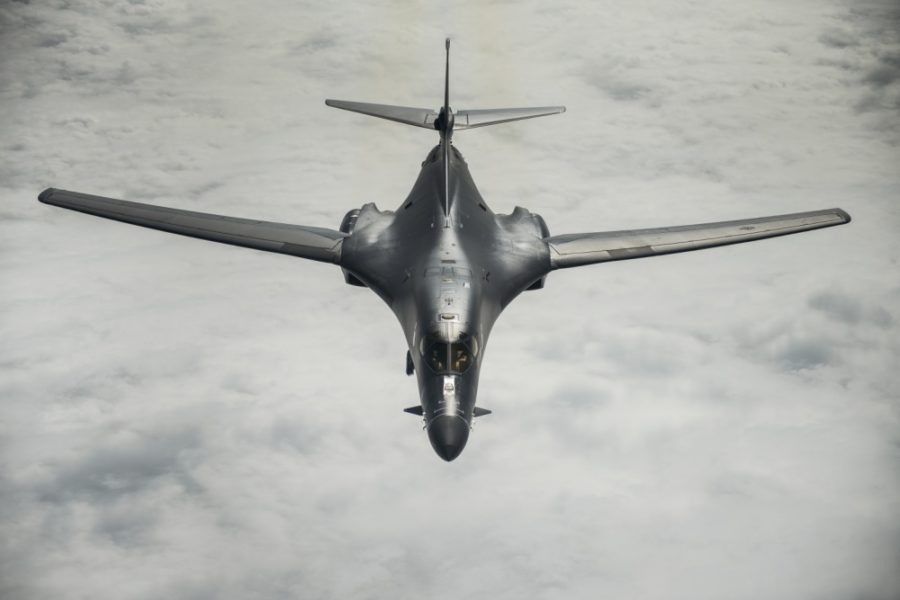The B-1B is a conventional, long-range, supersonic, penetrating strike aircraft derived from the canceled B-1A.
The B-1A first flew on Dec. 23, 1974, and four prototypes were developed and tested before program cancellation in 1977. The Reagan administration revived the program as the B-1B in 1981, adding 74,000 lb of usable payload, improved radar, and reduced radar cross section, but reducing speed to Mach 1.2.
Its three internal weapons bays can carry the largest payload of guided/unguided weapons in the Air Force inventory, and its blended wing/body and variable-geometry wing permit long-range/loiter time.
Offensive avionics include terrain-following SAR and a fully integrated Sniper ATP to track and target moving vehicles.
B-1B made its combat debut over Iraq during Desert Fox in 1998. The fleet completed its most comprehensive upgrade to date in September 2020. The three-part Integrated Battle Station (IBS) program added an all-digital glass cockpit, Fully Integrated Data Link (FIDL) to enhance targeting/ LOS/ BLOS C2, and Central Integrated Test System (CITS) for real-time simplified troubleshooting.
The fleet is also undergoing Multifunctional Information Distribution System/Joint Tactical Radio System (MIDS/JTRS) mods to improve situational awareness and retargeting abilities, and updated BLOS cryptography to sustain the aircraft’s connectivity.
The B-1B is USAF’s sole Long-Range Anti-Ship Missile (LRASM) carrier and its range, speed, and payload make it a key power-projection asset in USAF’s Indo-Asia Pacific strategy.
USAF is expanding the B-1B’s capacity to carry future weapons such as the AGM-183 ARRW hypersonic missile or 5,000 lb-class guided bombs. Recent demonstrations reconfigured the bomb bay to expand internal capacity, as well as use of the bomber’s previously deactivated external pylons to carry JDAM.
AFGSC retired 17 of the least serviceable airframes in FY21 and will divest, rather than repair, the aircraft damaged in a 2022 ground fire at Dyess. Recent retirements increased the fleet’s mission capable rate and USAF plans to keep enough B-1Bs to maintain capacity until the fleet is fully replaced by the B-21, targeted for 2032.
Contractor: Boeing (formerly Rockwell International).
First Flight: Oct. 18, 1984.
Delivered: June 1985-May 1988.
IOC: Oct. 1, 1986, Dyess AFB, Texas.
Production: 104.
Inventory: 45.
Operator: AFGSC, AFMC.
Aircraft Location: Dyess AFB, Texas; Edwards AFB, Calif.; Eglin AFB, Fla.; Ellsworth AFB, S.D.
Active Variant: B-1B. Upgraded production version of the B-1A.
Dimensions: Span 137 ft (forward sweep) to 79 ft (aft sweep), length 146 ft, height 34 ft.
Weight: Max T-O 477,000 lb.
Power Plant: Four GE Aviation F101-GE-102 turbofans, each 30,780 lb thrust.
Performance: Speed 900+ mph at S-L, range approx. 7,455 miles (further with air refueling).
Ceiling: More than 30,000 ft.
Armament: 84 Mk 82 (500-lb) or 24 Mk 84 (2,000-lb) general-purpose bombs; 84 Mk 62 (500-lb) or eight Mk 65 (2,000-lb) Quickstrike naval mines; 30 CBU-87/89 cluster bombs or 30 CBU-103/104/105 WCMDs; 24 GBU-31 or 15 GBU-38 JDAMs/GBU-54 JDAM; 24 AGM-158A JASSM, JASSM-ER, or LRASM.
Accommodation: Pilot, copilot, and two WSOs (offensive/defensive), on ACES II zero/zero ejection seats.
